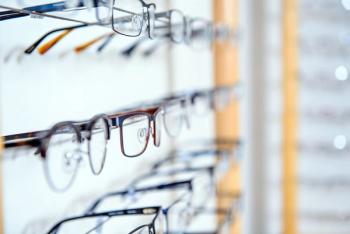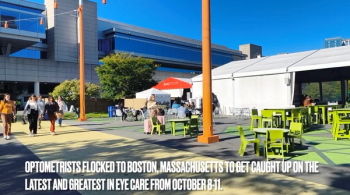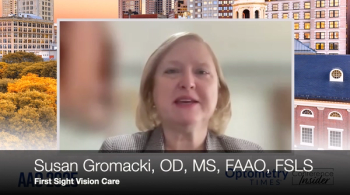
Optometry Times® news summary 10/25/2020
Assistant Editor Brooke Beery shares news updates for October 25, 2020.
With this week’s eye care update, I’m
A University of Houston biomedical researcher is developing new technology that will measure the stiffness of the lens in the eye, which is likely associated with presbyopia.
Currently, several investigational approaches are in process for presbyopia treatment that rely on lens softening or lens replacement with softer materials. Drug-associated lens softening approaches are expected to have a transformative impact on the field because they are non-invasive and they preserve the anatomical relationship between the lens and other tissues involved in focusing, but there is a significant roadblock to developing these procedures.
The National Eye Institute has awarded professor of biomedical engineering Kirill Larin 3 million dollars to create a new technology capable of precise noninvasive and depth-resolved quantitative measurements of the lens mechanical properties in a clinical setting.
The technology will combine Brillouin microscopy, optical coherence tomography, and optical coherence elastography—a new combination to be called BOE. The instrument will be used to generate the first age-dependent data on lens mechanical properties quantified in vivo as well as quantitatively assess therapeutic procedures aimed to restore the ability to focus.
New England College of Optometry or NECO says that eyewear brand Warby Parker has established a first-of-its-kind scholarship fund at NECO with the goal of increasing Black representation in the field of optometry.
One of the largest single donations from a vision care business in recent history, this generous $440,000 gift establishes the Warby Parker Scholarship to be awarded to two Black scholars and covers tuition for the College’s four-year doctor of optometry program. Recipients must exhibit leadership potential and have the desire to impact the field of optometry. The Warby Parker Scholarship fund is part of a larger joint diversity and inclusion initiativebetween the brand and the institution.
NECO recently signed on to the 13% Promise, a pledge led by Black Eyecare Perspective, which asks for greater equity and Black representation in eyecare companies, colleges of optometry, and optometry boards of trustees. Warby Parker has committed to 10 specific goals, one of which is to increase Black representation in the field of optometry and in the technology sector.
CooperVision reports the latest findings from its MiSight 1 day clinical study. One key takeaway that nearly one in four children’s eyes originally fit with the company’s MiSight 1 day remain stable for myopia after six years.
The findings also suggest that while intervention at an early age is optimal with MiSight 1 day, beginning treatment at an older age could similarly slow the rate of myopia progression, according to the company. The original control group was refit into the dual-focus lens in Year 4. Comparing this population to the children fit with MiSight 1 day at initiation, there have been similar rates of myopia progression and axial length growth in the subsequent three years of assessment.
Six-year results continue to demonstrate excellent safety profile, wearing time, and visual acuity for children in daily disposable contact lenses over 653 wearing years.
Tarsus Pharmaceuticals announced data from its Phase 2 trials, Io (a Phase 2a, single-arm open-label trial) and Europa (a Phase 2b, randomized vehicle-controlled trial), evaluating the safety and efficacy of TP-03, a novel ophthalmic therapeutic for the treatment of demodex blepharitis. Both studies produced data on the safety, efficacy, and tolerability of TP-03, consistent with findings from the company's previous Mars and Jupiter Phase 2 trials.
According to the company, in the Phase 2a Io trial, treatment with TP-03 was effective at achieving the primary and secondary endpoints, respectively, of collarette cure in 72% of participants and mite eradication in 78% of participants at Day 42.
In the Phase 2b Europa trial, statistically significant results were achieved for the primary endpoint of collarette cure by 80% of participants on TP-03 compared to 16% on vehicle at Day 42. The secondary endpoint of mite eradication by 73% of participants on TP-03 compared to 21% on vehicle at Day 42.
TP-03 was well tolerated, and there were no reports of serious adverse events or treatment discontinuations due to adverse events in either study.
The Io and Europa trials included adults aged 18 years or older with more than 10 collarettes present on the upper lid and mild-to-severe lid margin erythema. Participants had at least 1.5 mites per lash on the upper and lower eyelids combined. One drop of the TP-03 treatment was dosed twice per day in each eye for 42 days. Enrolled participants received no treatment for blepharitis symptoms, such as lid hygiene, during the study, as well as 14 days prior.
Additionally, Tarsus has begun patient enrollment and treatment in its Saturn-1 Phase 2b/3 pivotal trial. Saturn-1 is a larger, multi-center trial with the same endpoints as the Europa Phase 2b trial. Enrollment in the Saturn-1 trial began in September 2020 and a second pivotal trial, Saturn-2, is expected to begin in 2021.
Johns Hopkins Medicine biomedical engineering student Christopher Shallal developed an initiative to keep healthcare teams safe by galvanizing community members to use 3D printers to make face shields.
Shallal led the 3D Printing Hopkins Volunteer Network, which included students and staff members at Hopkins campuses in Baltimore and members of the community. The team provided instructions and materials to volunteers who used their 3D printers to make reusable face shields that can be sterilized and provided to Hopkins healthcare professionals working on the front lines of the pandemic.
Thus far, their efforts have produced and circulated more than 8,000 face shields for healthcare workers. They also created and distributed more than 8,000 ear saver clips that wrap around the head to protect the back of the ear from the elastic bands on masks.
New consumer research from CooperVision reveals that the COVID-19 pandemic has led to increased digital device use among Americans, and many are experiencing its effects on their eyes. The survey—conducted among nearly 2,500 adults in the United States—also shows significant opportunity for eyecare professionals to discuss digital eye strain with their patients.
The data supports CooperVision’s campaign aimed at educating consumers about the prevalence of digital device use and digital eye strain. The campaign kicked off with social media and display ads in August, and includes a partnership with digital lifestyle and technology influencer Jessica Naziri.
Extended screen time, already a trend heading into 2020, has become a way of life. About 70% of respondents ages 18-54 reported they spend more than half of their day looking at screens, while 1 in 3 people said more than 75% of their day is spent on digital devices.
Of those surveyed, 77% experience digital eye strain at some point during the day. The evening and late-night hours are the most common times of day to experience feelings of eye discomfort, tiredness and dryness from looking at screens.
John Weiss & Son launches its Merilas 810 shortpulse laser in the UK.
The Merilas 810 shortpulse laser provides glaucoma and retina treatments and offers new laser therapy for advanced and end-stage glaucoma. The system offers transscleral cyclophotocoagulation, which may safely reduce intraocular pressure in patients where previous medications and treatments were not effective, according to the company.
The laser has a rapid start-up time, and the detachable touch-screen display features an easy-to-use, intuitive design for full flexibility for the user
The Merilas 810’s thermal-electrical cooling system ensures quiet operation. It requires no ventilation slots, which ensures that no dust can penetrate the interior of the laser.
All Merilas lasers are small and compact, allowing easy transportation.
The Contact Lens Institute or CLI has launched The EASY Way—which is Eyes, Awareness, Safety and You—to generate greater consumer familiarity with contact lens health and safety year-round in the U.S. and Canada. The program includes simplified wear and care tips, attention-grabbing infographics, and companion digital resources for eyecare professionals and staff to use in their practices. These resources are available from EASYWayProgram.org.
At the center of the program are three easy steps to healthy, comfortable contact lens wear:
• Think cean
• Remember fresher is better
• Trust your eye doctor
New research conducted by CLI among U.S. adults ages 18-54 found The EASY Way method to be well understood, memorable, and easy to follow.
Now, I join Editor in Chief Gretchyn Bailey to talk with celebrity spokesperson Sarah Michelle Gellar about her family’s experience with myopia management, and I talk with Chief Optometric Editor Dr. Ben Casella about the use of vitamin B3 for glaucoma management.
Newsletter
Want more insights like this? Subscribe to Optometry Times and get clinical pearls and practice tips delivered straight to your inbox.



















































.png)


